外研版(2019)选择性必修第三册Unit 5 Learning from Nature Using language Grammar Grammar 课件(共17张PPT)
文档属性
| 名称 | 外研版(2019)选择性必修第三册Unit 5 Learning from Nature Using language Grammar Grammar 课件(共17张PPT) | 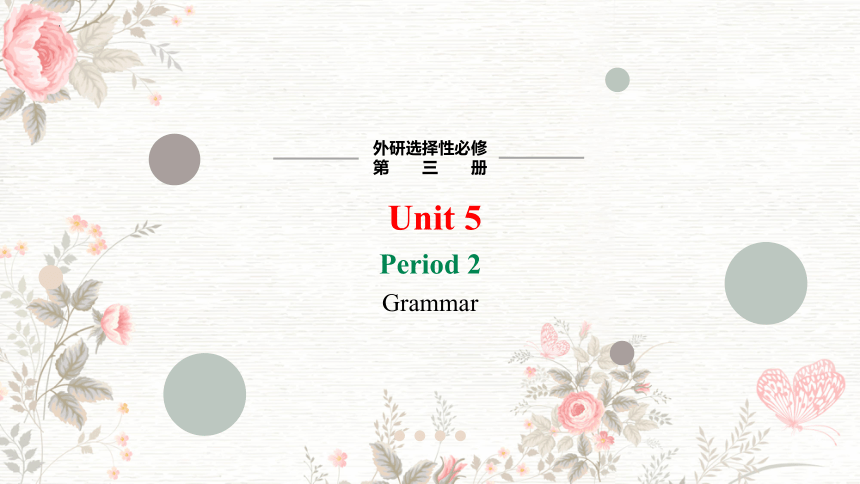 | |
| 格式 | pptx | ||
| 文件大小 | 6.3MB | ||
| 资源类型 | 教案 | ||
| 版本资源 | 外研版(2019) | ||
| 科目 | 英语 | ||
| 更新时间 | 2024-03-21 11:30:14 | ||
图片预览

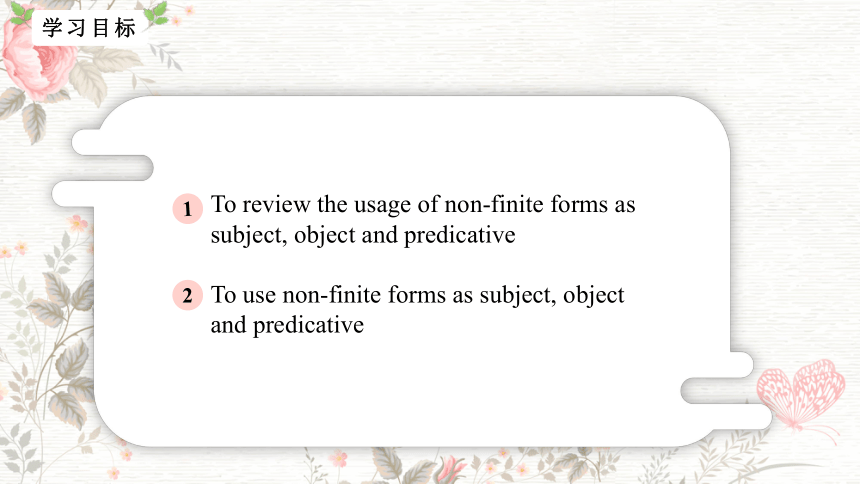
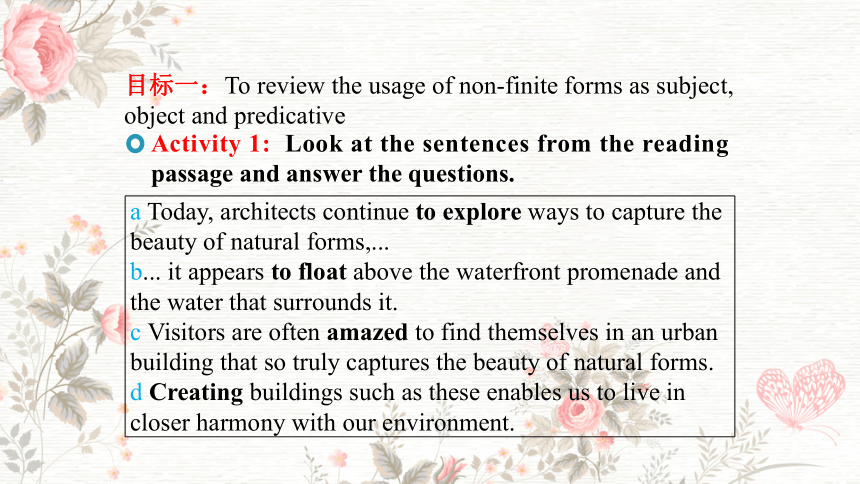
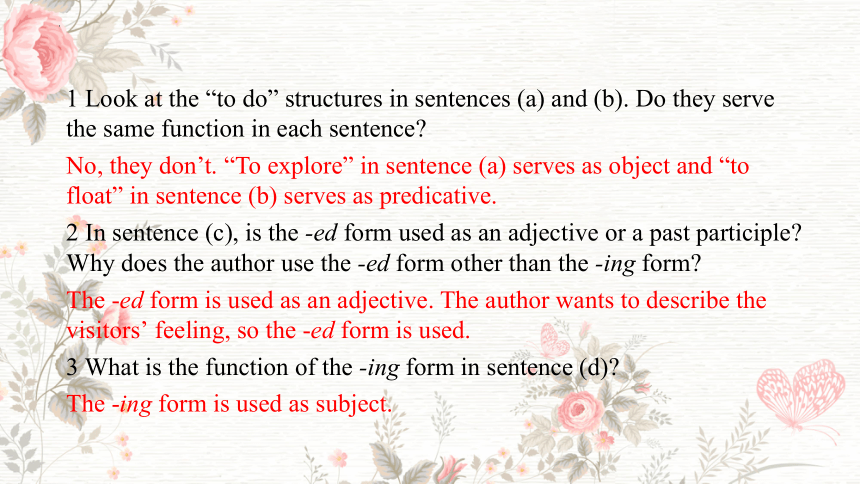
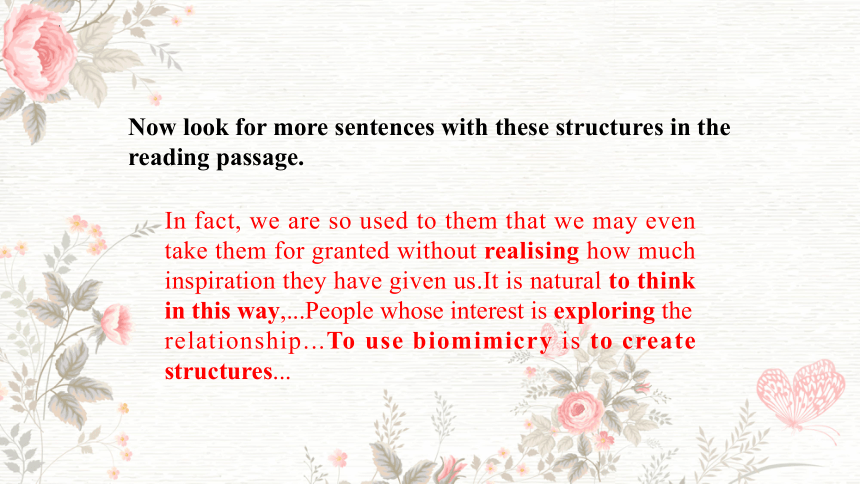
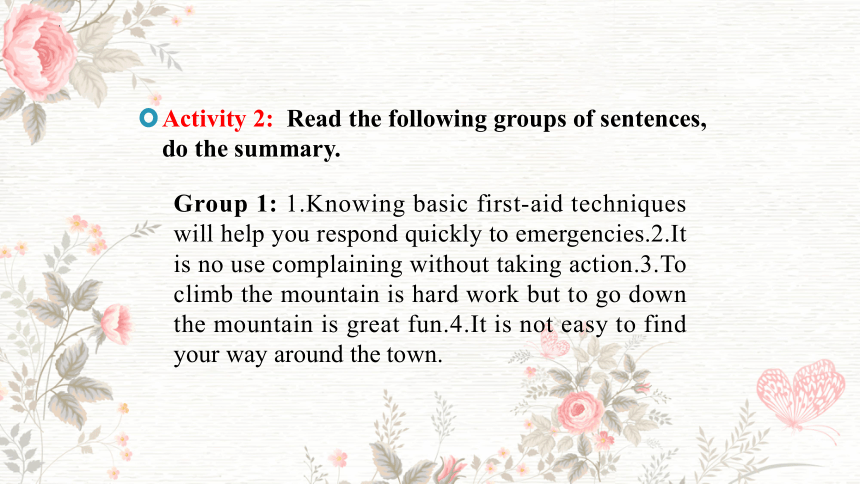
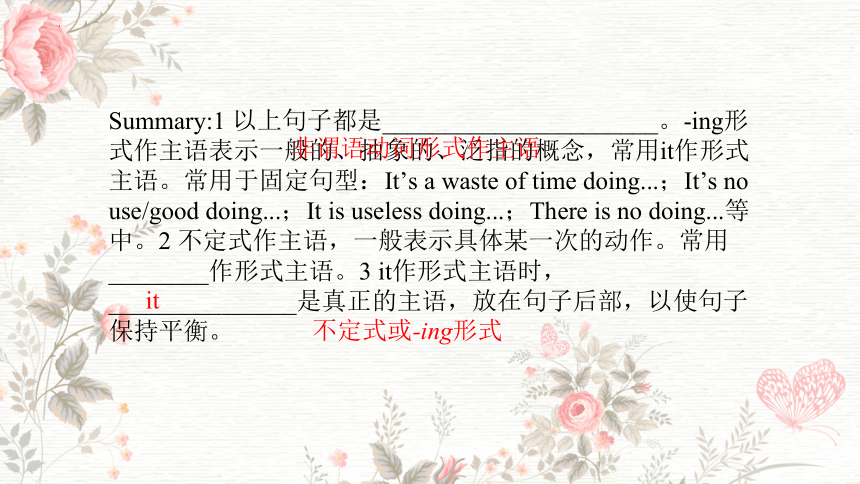
文档简介
(共17张PPT)
外研选择性必修
第三册
Unit 5
Period 2
Grammar
1
2
To review the usage of non-finite forms as subject, object and predicative
To use non-finite forms as subject, object and predicative
目标一:To review the usage of non-finite forms as subject, object and predicative
Activity 1: Look at the sentences from the reading passage and answer the questions.
a Today, architects continue to explore ways to capture the beauty of natural forms,...
b... it appears to float above the waterfront promenade and the water that surrounds it.
c Visitors are often amazed to find themselves in an urban building that so truly captures the beauty of natural forms.
d Creating buildings such as these enables us to live in closer harmony with our environment.
1 Look at the “to do” structures in sentences (a) and (b). Do they serve the same function in each sentence
No, they don’t. “To explore” in sentence (a) serves as object and “to float” in sentence (b) serves as predicative.
2 In sentence (c), is the -ed form used as an adjective or a past participle Why does the author use the -ed form other than the -ing form
The -ed form is used as an adjective. The author wants to describe the visitors’ feeling, so the -ed form is used.
3 What is the function of the -ing form in sentence (d)
The -ing form is used as subject.
Now look for more sentences with these structures in the reading passage.
In fact, we are so used to them that we may even take them for granted without realising how much inspiration they have given us.It is natural to think in this way,...People whose interest is exploring the relationship...To use biomimicry is to create structures...
Activity 2: Read the following groups of sentences, do the summary.
Group 1: 1.Knowing basic first-aid techniques will help you respond quickly to emergencies.2.It is no use complaining without taking action.3.To climb the mountain is hard work but to go down the mountain is great fun.4.It is not easy to find your way around the town.
Summary:1 以上句子都是______________________。-ing形式作主语表示一般的、抽象的、泛指的概念,常用it作形式主语。常用于固定句型:It’s a waste of time doing...;It’s no use/good doing...;It is useless doing...;There is no doing...等中。2 不定式作主语,一般表示具体某一次的动作。常用________作形式主语。3 it作形式主语时,_______________是真正的主语,放在句子后部,以使句子保持平衡。
非谓语动词形式作主语
it
不定式或-ing形式
Group 2: 1. My English teacher promised to lend some books to me.2. We only missed seeing each other by five minutes.3. Do you mind being interrupted while studying 4. My mother couldn’t help smiling when she heard the good news.
Summary:以上都是非谓语动词形式作____________。
宾语
1 下列动词后只能用不定式作宾语,请牢记下面的口诀:决心学会想希望,拒绝设法愿假装。主动答应选计划,同意请求帮一帮。decide/determine,learn,want,expect/hope/wish;refuse,manage,care,pretend;offer,promise,choose,plan;agree,ask/beg,help另外afford,strive,happen,wait,threaten也要用不定式作宾语。
2 下列动词或动词短语后只能用-ing形式作宾语,请牢记下面的口诀:
考虑建议盼原谅,承认推迟没得想。避免错过继续练,否认完成就欣赏。禁止想象才冒险,不禁介意准逃亡。consider,suggest/advise,look forward to,excuse/pardon;admit,delay/put off,fancy(想象,假设);avoid,miss,keep/keep on,practice;deny,finish,enjoy/appreciate;forbid,imagine,risk;can't help,mind,allow/permit,escape。
3 下列动词或动词短语后既可以用-ing形式作宾语,也可以用不定式作宾语,但意义上有区别,要特别注意:
regret to do sth. 遗憾要去做某事 regret doing sth.
后悔做过某事
forget to do sth. 忘记要去做某事 forget doing sth.
忘记已做过某事
remember to do sth. 记得要去做某事 remember doing sth.
记得做过某事
Group 3:1. His wish is to be a doctor in the future.2. My job is to clean the rooms every day.3. Our task is playing all kinds of music.4. My job is teaching.Summary:以上都是非谓语动词形式作____________。
表语
目标二: To use non-finite forms as subject, object and predicative
Activity 1: Complete the passage with the correct form of the verbs in brackets.
1 __________ (draw) inspiration from nature is a tradition that goes back centuries. Nowhere is this better illustrated than in the beautiful Lingering Garden of Suzhou. The main principle of its design is 2 _____________________ (recreate) natural landscapes in miniature. First established in the Ming Dynasty, the original garden contained a rockery to symbolise Tiantai Mountain. Pine and bamboo groves were added later, along with a pond and an island. Visitors would be 3 __________ (astonish) to find the garden modeled closely on natural features. Visitors are also supposed 4 __________ (explore) it scene-by-scene. This could vary from a view of a pond and the splashing of fish, to a tree in blossom, a pagoda or a moon-shaped gate.
Drawing
to recreate / recreating
astonished
to explore
Activity 2: Read the information below and write a paragraph introducing the 24 Solar Terms with the words in the box. Use the structures you have learnt in this unit where appropriate.
learn determine
show amaze use
Learning from nature’s wisdom led farmers in Ancient China to create the 24 Solar Terms...
Learning from nature’s wisdom led farmers in Ancient China to create the 24 Solar Terms, which were based on observation of changes of seasons, astronomy and other natural phenomena. Indicating changes in weather conditions, the 24 Solar Terms remain of particular importance to farmers for guiding their practices. The first term is known as “Beginning of Spring”, and marks when days become longer and the temperature begins to increase. Nowadays, the 24 Solar Terms not only apply to farming, but also guide Chinese people in everyday life. So varied are the functions of the Solar Terms and their contributions to cultural identity, that in 2016, they were added to UNESCO’s List of Intangible Cultural Heritage.
Activity 3: Work in pairs. Talk about one of the Solar Terms using the structures you have learnt in this unit where appropriate.
立春 the Beginning of Spring (1st solar term)雨水 Rain Water (2nd solar term) 惊蛰 the Waking of Insects (3rd solar term) 春分 the Spring Equinox (4th solar term) 清明 Pure Brightness (5th solar term) 谷雨 Grain Rain (6th solar term) 立夏 the Beginning of Summer (7th solar term) 小满 Lesser Fullness of Grain (8th solar term) 芒种 Grain in Beard (9th solar term)夏至 the Summer Solstice (10th solar term) 小暑 Lesser Heat (11th solar term)大暑 Greater Heat (12th solar term)
立秋 the Beginning of Autumn (13th solar term)处暑 the End of Heat (14th solar term)白露 White Dew (15th solar term)秋分 the Autumn Equinox (16th solar term) 寒露 Cold Dew (17th solar term) 霜降 Frost’s Descent (18th solar term) 立冬 the Beginning of Winter (19th solar term) 小雪 Lesser Snow (20th solar term) 大雪 Greater Snow (21st solar term) 冬至 the Winter Solstice (22nd solar term) 小寒 Lesser Cold (23rd solar term)大寒 Greater Cold (24th solar term)
1 Can you recall the usage of non-finite forms as subject, object and predicative 2 Can you use the structures to describe another Solar Term
外研选择性必修
第三册
Unit 5
Period 2
Grammar
1
2
To review the usage of non-finite forms as subject, object and predicative
To use non-finite forms as subject, object and predicative
目标一:To review the usage of non-finite forms as subject, object and predicative
Activity 1: Look at the sentences from the reading passage and answer the questions.
a Today, architects continue to explore ways to capture the beauty of natural forms,...
b... it appears to float above the waterfront promenade and the water that surrounds it.
c Visitors are often amazed to find themselves in an urban building that so truly captures the beauty of natural forms.
d Creating buildings such as these enables us to live in closer harmony with our environment.
1 Look at the “to do” structures in sentences (a) and (b). Do they serve the same function in each sentence
No, they don’t. “To explore” in sentence (a) serves as object and “to float” in sentence (b) serves as predicative.
2 In sentence (c), is the -ed form used as an adjective or a past participle Why does the author use the -ed form other than the -ing form
The -ed form is used as an adjective. The author wants to describe the visitors’ feeling, so the -ed form is used.
3 What is the function of the -ing form in sentence (d)
The -ing form is used as subject.
Now look for more sentences with these structures in the reading passage.
In fact, we are so used to them that we may even take them for granted without realising how much inspiration they have given us.It is natural to think in this way,...People whose interest is exploring the relationship...To use biomimicry is to create structures...
Activity 2: Read the following groups of sentences, do the summary.
Group 1: 1.Knowing basic first-aid techniques will help you respond quickly to emergencies.2.It is no use complaining without taking action.3.To climb the mountain is hard work but to go down the mountain is great fun.4.It is not easy to find your way around the town.
Summary:1 以上句子都是______________________。-ing形式作主语表示一般的、抽象的、泛指的概念,常用it作形式主语。常用于固定句型:It’s a waste of time doing...;It’s no use/good doing...;It is useless doing...;There is no doing...等中。2 不定式作主语,一般表示具体某一次的动作。常用________作形式主语。3 it作形式主语时,_______________是真正的主语,放在句子后部,以使句子保持平衡。
非谓语动词形式作主语
it
不定式或-ing形式
Group 2: 1. My English teacher promised to lend some books to me.2. We only missed seeing each other by five minutes.3. Do you mind being interrupted while studying 4. My mother couldn’t help smiling when she heard the good news.
Summary:以上都是非谓语动词形式作____________。
宾语
1 下列动词后只能用不定式作宾语,请牢记下面的口诀:决心学会想希望,拒绝设法愿假装。主动答应选计划,同意请求帮一帮。decide/determine,learn,want,expect/hope/wish;refuse,manage,care,pretend;offer,promise,choose,plan;agree,ask/beg,help另外afford,strive,happen,wait,threaten也要用不定式作宾语。
2 下列动词或动词短语后只能用-ing形式作宾语,请牢记下面的口诀:
考虑建议盼原谅,承认推迟没得想。避免错过继续练,否认完成就欣赏。禁止想象才冒险,不禁介意准逃亡。consider,suggest/advise,look forward to,excuse/pardon;admit,delay/put off,fancy(想象,假设);avoid,miss,keep/keep on,practice;deny,finish,enjoy/appreciate;forbid,imagine,risk;can't help,mind,allow/permit,escape。
3 下列动词或动词短语后既可以用-ing形式作宾语,也可以用不定式作宾语,但意义上有区别,要特别注意:
regret to do sth. 遗憾要去做某事 regret doing sth.
后悔做过某事
forget to do sth. 忘记要去做某事 forget doing sth.
忘记已做过某事
remember to do sth. 记得要去做某事 remember doing sth.
记得做过某事
Group 3:1. His wish is to be a doctor in the future.2. My job is to clean the rooms every day.3. Our task is playing all kinds of music.4. My job is teaching.Summary:以上都是非谓语动词形式作____________。
表语
目标二: To use non-finite forms as subject, object and predicative
Activity 1: Complete the passage with the correct form of the verbs in brackets.
1 __________ (draw) inspiration from nature is a tradition that goes back centuries. Nowhere is this better illustrated than in the beautiful Lingering Garden of Suzhou. The main principle of its design is 2 _____________________ (recreate) natural landscapes in miniature. First established in the Ming Dynasty, the original garden contained a rockery to symbolise Tiantai Mountain. Pine and bamboo groves were added later, along with a pond and an island. Visitors would be 3 __________ (astonish) to find the garden modeled closely on natural features. Visitors are also supposed 4 __________ (explore) it scene-by-scene. This could vary from a view of a pond and the splashing of fish, to a tree in blossom, a pagoda or a moon-shaped gate.
Drawing
to recreate / recreating
astonished
to explore
Activity 2: Read the information below and write a paragraph introducing the 24 Solar Terms with the words in the box. Use the structures you have learnt in this unit where appropriate.
learn determine
show amaze use
Learning from nature’s wisdom led farmers in Ancient China to create the 24 Solar Terms...
Learning from nature’s wisdom led farmers in Ancient China to create the 24 Solar Terms, which were based on observation of changes of seasons, astronomy and other natural phenomena. Indicating changes in weather conditions, the 24 Solar Terms remain of particular importance to farmers for guiding their practices. The first term is known as “Beginning of Spring”, and marks when days become longer and the temperature begins to increase. Nowadays, the 24 Solar Terms not only apply to farming, but also guide Chinese people in everyday life. So varied are the functions of the Solar Terms and their contributions to cultural identity, that in 2016, they were added to UNESCO’s List of Intangible Cultural Heritage.
Activity 3: Work in pairs. Talk about one of the Solar Terms using the structures you have learnt in this unit where appropriate.
立春 the Beginning of Spring (1st solar term)雨水 Rain Water (2nd solar term) 惊蛰 the Waking of Insects (3rd solar term) 春分 the Spring Equinox (4th solar term) 清明 Pure Brightness (5th solar term) 谷雨 Grain Rain (6th solar term) 立夏 the Beginning of Summer (7th solar term) 小满 Lesser Fullness of Grain (8th solar term) 芒种 Grain in Beard (9th solar term)夏至 the Summer Solstice (10th solar term) 小暑 Lesser Heat (11th solar term)大暑 Greater Heat (12th solar term)
立秋 the Beginning of Autumn (13th solar term)处暑 the End of Heat (14th solar term)白露 White Dew (15th solar term)秋分 the Autumn Equinox (16th solar term) 寒露 Cold Dew (17th solar term) 霜降 Frost’s Descent (18th solar term) 立冬 the Beginning of Winter (19th solar term) 小雪 Lesser Snow (20th solar term) 大雪 Greater Snow (21st solar term) 冬至 the Winter Solstice (22nd solar term) 小寒 Lesser Cold (23rd solar term)大寒 Greater Cold (24th solar term)
1 Can you recall the usage of non-finite forms as subject, object and predicative 2 Can you use the structures to describe another Solar Term
